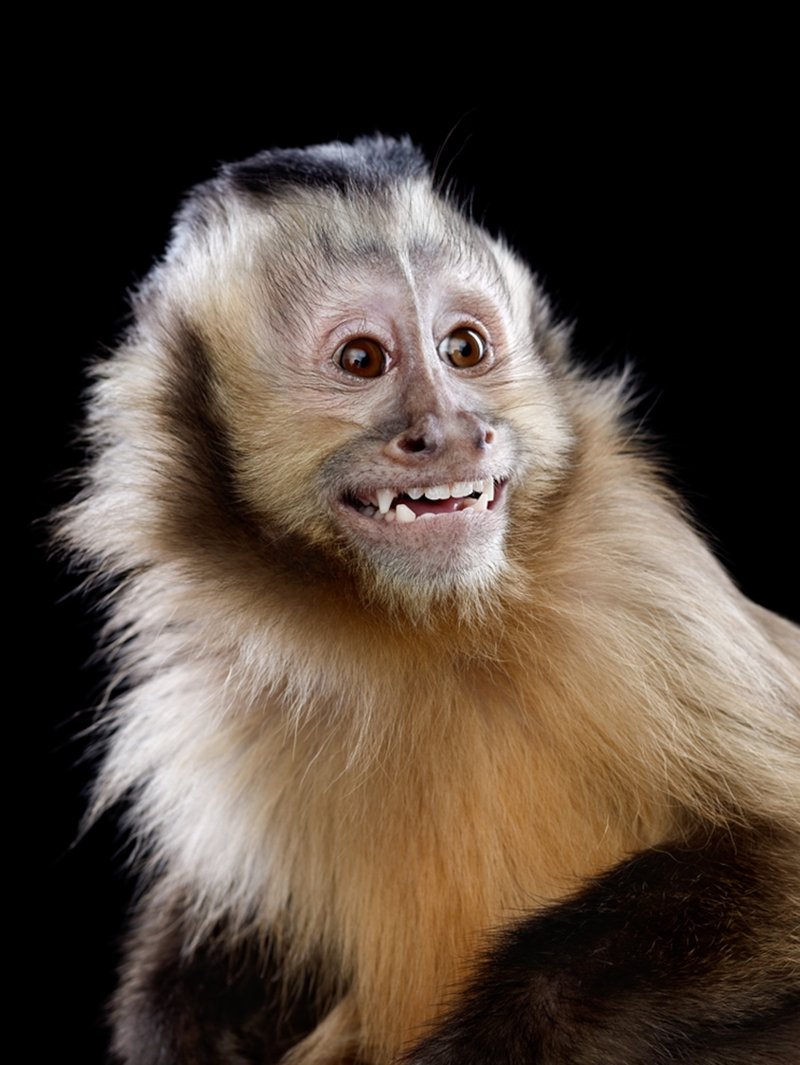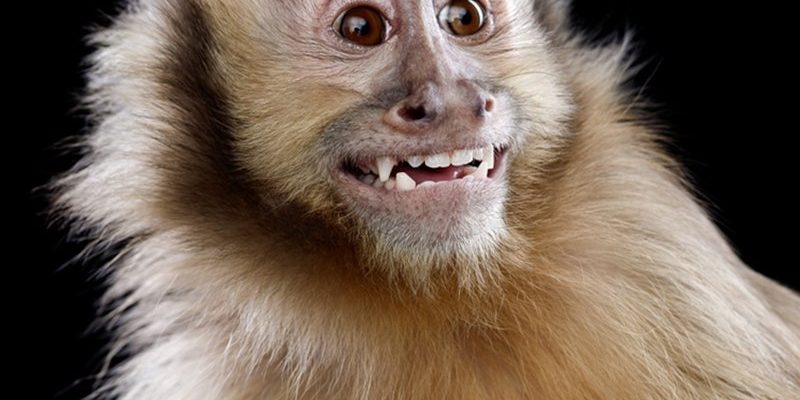
Think of this as a little adventure into the lives of some remarkable creatures. Each of them has its own unique traits, just like you and me. In this guide, you’ll not only learn who these animals are but also how to distinguish them from capuchins and from each other. So, grab your favorite drink, and let’s explore together!
1. Squirrel Monkeys: The Tiny Acrobats
Squirrel monkeys might just be the closest relatives to capuchin monkeys you can find. These little guys are agile and love to leap from branch to branch in their tropical habitats. At first glance, you might think they’re capuchins, but there are some key differences.
Appearance: Squirrel monkeys are smaller, weighing around 15-20 pounds, whereas capuchins can weigh up to 50 pounds. Look for the striking differences in their fur; squirrel monkeys often have bright yellow-orange fur on the underside, which contrasts with their darker upper body.
Behavior: While both types of monkeys are playful, squirrel monkeys tend to be a bit more social in larger groups, often forming tight-knit bonds. They communicate through a series of chirps, which you might not hear from capuchins as often.
If you ever encounter one in the wild or at a zoo, pay attention to their playful leaps and bright coloration—it’s a sure sign you’re observing a squirrel monkey!
2. Howler Monkeys: The Vocal Powerhouses
If you’ve ever been in the tropical forests of Central or South America, you may have heard the deep, resonant howls of a howler monkey. This is where they get their name, but they are quite different from capuchins.
Sound: Howler monkeys have a unique voice due to their enlarged hyoid bone, which allows them to produce loud calls that can be heard up to three miles away. In contrast, capuchin monkeys communicate in a more subdued manner.
Physical Characteristics: Howler monkeys typically have larger bodies and longer limbs than capuchins. Their fur can vary from black to reddish-brown, often making them look more imposing.
While both species are social, howler monkeys tend to hang out in smaller family groups that are a bit quieter when they’re not vocalizing. Next time you hear that haunting howling echoing through the trees, you can bet it’s a howler monkey, not a capuchin!
3. Tamarins: The Miniature Marvels
Tamarins are another group of monkeys that often get compared to capuchins, but they bring their own flair to the jungle. Smaller and often cuter, tamarins have a unique charm that’s hard to resist.
Distinctive Features: Tamarins are usually less than 10 pounds and have long, thin tails that help them balance. They often sport distinctive facial hair and tufts that can make them look like they’re dressed for a fancy event, unlike the more straightforward look of capuchins.
Social Structure: Tamarins live in family groups and often exhibit cooperative breeding, where other group members help care for the young. This is quite different from the often independent lifestyle of a capuchin monkey.
If you spot a tamarin, pay attention to their lively interactions—it’s a beautiful display of family and community!
4. Macaques: The Adaptable Primates
Macaques are a larger group of Old World monkeys that share some similarities with capuchins but also have their own distinct traits. You’ll find them thriving in diverse environments, from cities to forests.
Adaptability: One of the most remarkable things about macaques is their adaptability. They’ve been known to live in urban areas, scavenging for food. Capuchins, on the other hand, prefer forested areas.
Appearance: Macaques come in various sizes and fur colors, from brown to gray, which can make them look quite different from the capuchin’s characteristic black and white face.
When you see a macaque, notice how they interact with their surroundings and their cleverness in finding food. It’s a testament to how diverse the animal kingdom can be!
5. Colobus Monkeys: The Elegant Leapers
Colobus monkeys are often regarded as some of the more graceful primates, known for their long limbs and unique fur patterns. They definitely stand out from capuchins in many ways.
Physical Traits: Colobus monkeys have a striking black and white coloration, with some species sporting a mane of white fur. They have no thumb, which gives them a unique appearance and makes them very specialized climbers—quite different from the slightly more robust capuchins.
Diet: Unlike capuchins, who are omnivorous, colobus monkeys primarily eat leaves, which means they have a different digestive system adapted for processing plant material.
If you ever see a colobus monkey gliding through the trees, it’s a beautiful sight—you’ll be witnessing nature’s elegance in motion.
6. Marmosets: The Tiny Titans
Marmosets are perhaps the cutest on our list, packing a lot of personality into their tiny frames. They might be small, but their energy rivals that of capuchins.
Size Comparison: Marmosets weigh just about 5 pounds, making them one of the smallest primates. Their size sets them apart from capuchins, which are more robust and larger.
Social Behavior: Marmosets are highly social, often staying in family groups. They engage in playful interactions and communicate with a variety of vocalizations, just like capuchins. However, their smaller size means they often have a much different social dynamic.
Next time you see a marmoset jumping around, take a moment to appreciate their spirited nature—it’s a joy to watch!
7. Capuchin Monkeys: A Deeper Dive
Let’s not forget the capuchin monkeys themselves! Often overlooked in a list like this, they have unique traits that deserve a closer look.
Personality: Capuchins are known for their intelligence and ability to use tools, which sets them apart from many other primate species. They can often be seen using sticks to extract insects from trees or cracking nuts open.
Social Structure: They live in social groups that are often close-knit, providing support to one another. Their social interactions can be quite complex, ranging from grooming to playing.
So, if you find yourself in the presence of a capuchin monkey, take a moment to observe their clever antics. You might just learn something new about the world of primates!
8. Spix’s Macaw: The Avian Cousin
While it’s not a monkey, Spix’s Macaw is worth mentioning due to its similar habitats and playful nature. This bird shares a vibrant personality reminiscent of capuchins, despite being entirely different in form.
Color and Personality: Spix’s Macaws have striking blue feathers and are known for their intelligence. Just like capuchins, they are very social and thrive on interaction.
Endangerment: Unfortunately, both species face threats to their habitats. Understanding these animals is crucial for conservation efforts, as we need to protect their homes.
If you ever spot a Spix’s Macaw in a sanctuary, it’s a sight to behold—both beautiful and inspiring.
9. Baboons: The Social Giants
Baboons are much larger than capuchins and can appear quite imposing. However, they share some social structures and behaviors that make them fascinating to compare.
Social Dynamics: Baboons live in troops that can have over a hundred members, showcasing a complex hierarchy. Capuchins also live in groups but are much smaller in size and scale.
Adaptability: Baboons are incredibly adaptable and can thrive in various environments, including savanna and urban areas. They have been known to forage for food in garbage bins—something capuchins avoid.
If you come across a troop of baboons, watch their interactions; it’s a captivating display of social behaviors that tells you a lot about their community dynamics.
10. Geladas: The Grass-Eating Monkeys
Geladas are often mistaken for baboons but are unique in their own right. These primates are primarily herbivorous, focusing on grasses, which is quite different from the varied diet of capuchins.
Appearance: Geladas have a distinct look, with long, flowing hair and a characteristic red patch on their chest. This sets them apart visually from capuchins, which have shorter fur.
Social Structure: They live in large groups, similar to baboons, but their interactions are often quieter. Unlike capuchins, geladas are known for their peaceful grazing habits, bringing a calm energy to the group dynamics.
Watching a gelada family interact can be remarkably soothing; it’s like enjoying a gentle dance of social harmony.
In conclusion, exploring the world of animals similar to capuchin monkeys reveals a treasure trove of diversity in the animal kingdom. From the playful squirrel monkeys to the elegant colobus, each species has its own unique traits and behaviors. Understanding these differences not only enriches our knowledge of wildlife but also highlights the importance of conservation efforts. So, the next time you see a capuchin or one of its relatives, take a moment to appreciate the rich tapestry of life they represent!

